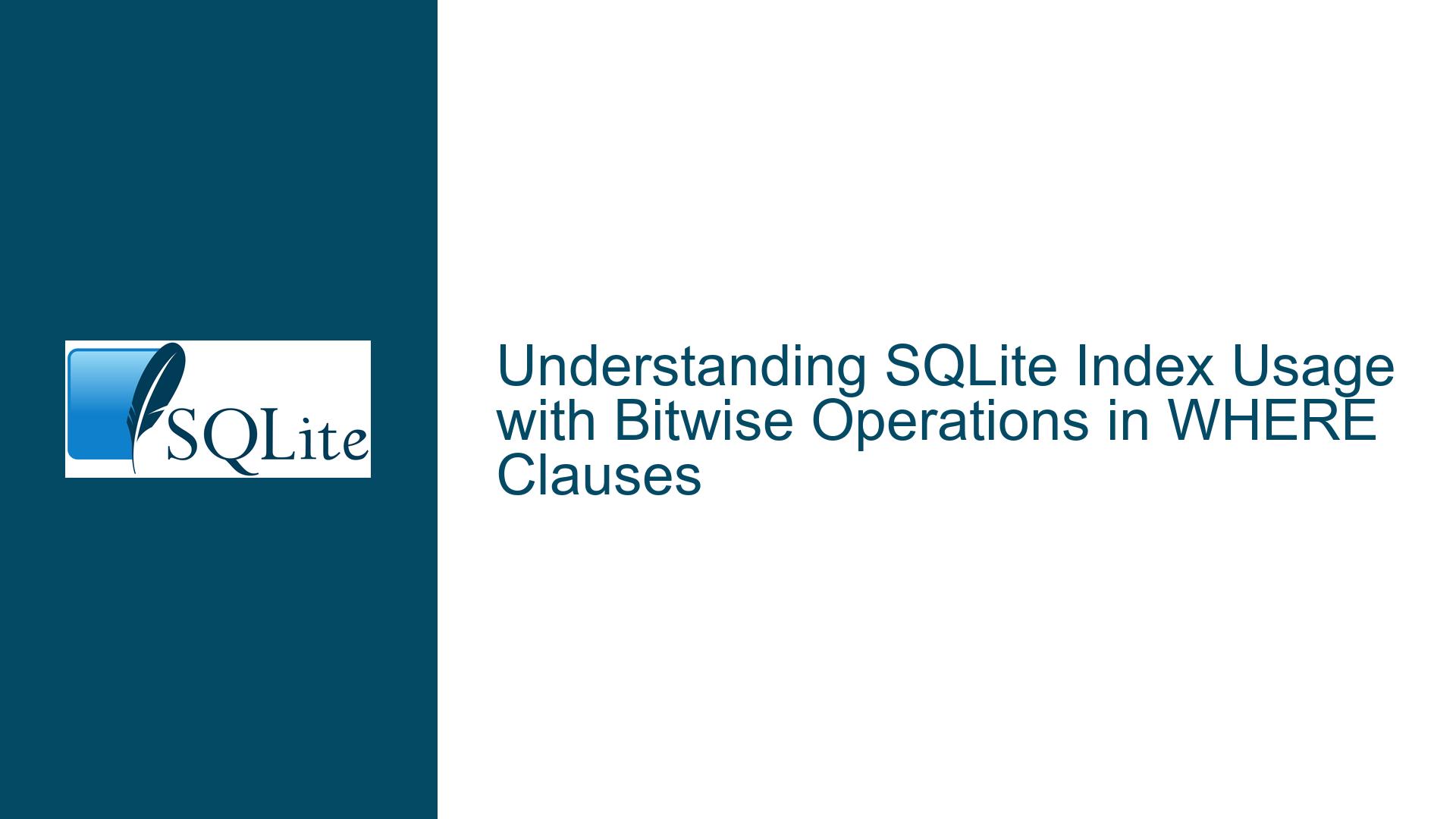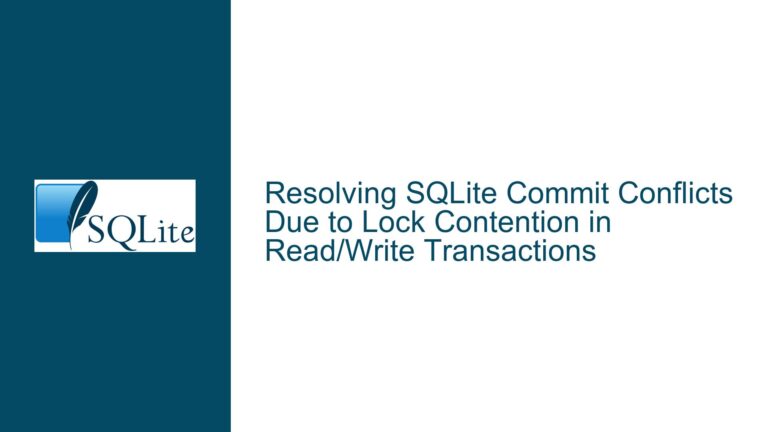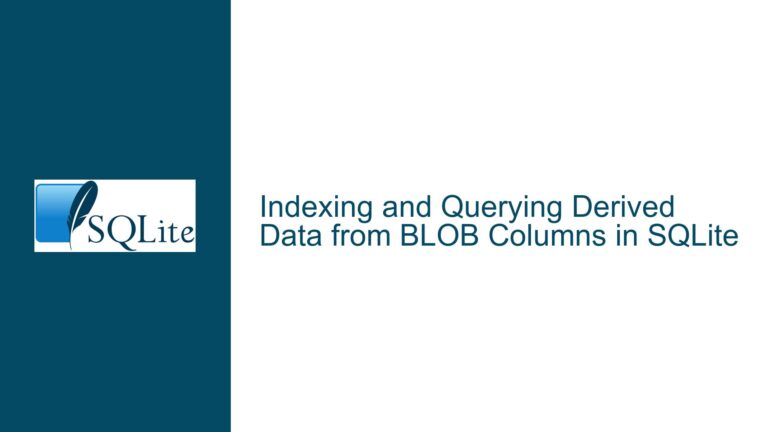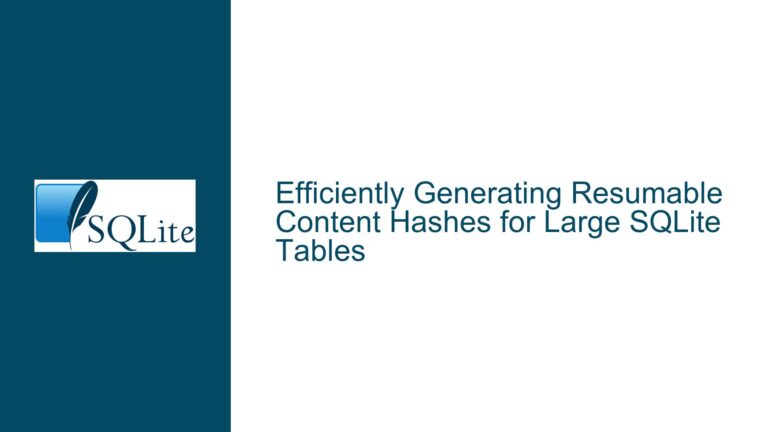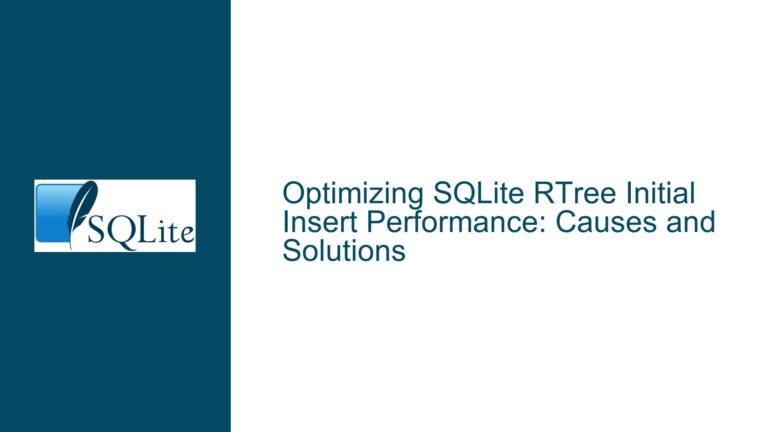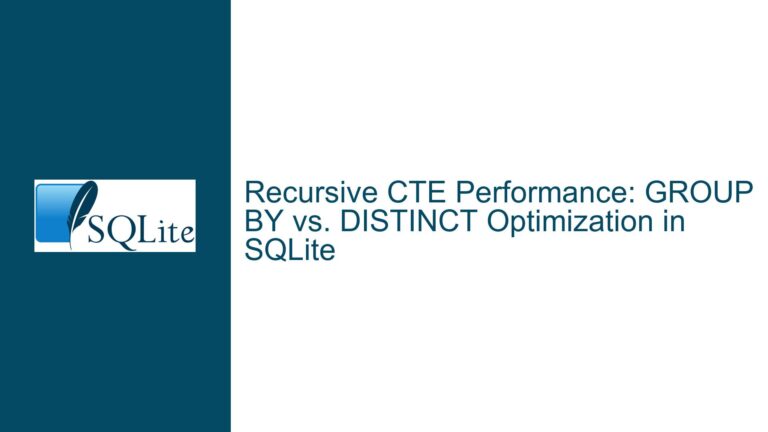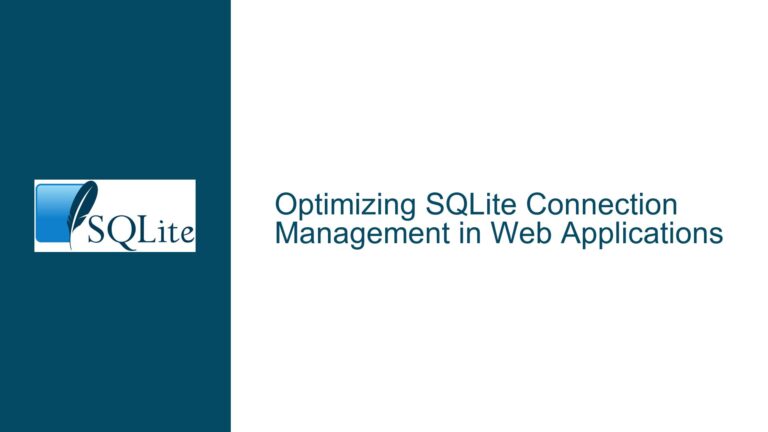SQLite Index Usage with Bitwise Operations in WHERE Clauses
Issue Overview: Absence of Index Utilization for Bitwise Conditions in SQLite Queries
When working with SQLite, developers often rely on indexes to optimize query performance. A common expectation is that indexes will be leveraged whenever a WHERE clause references an indexed column. However, specific types of conditions—particularly those involving bitwise operators like & (bitwise AND) combined with equality/inequality checks—do not trigger index usage in SQLite. This behavior is observed even when columns are explicitly indexed and other comparison operators (e.g., =, >, <) successfully utilize those indexes.
Key Observations from the Discussion
Index Behavior with Standard Comparisons:
Queries using equality (WHERE package = ?) or range conditions (WHERE package > ?) leverage existing indexes (e.g.,IDX_Resource_Package_Index__WorkId), as confirmed byEXPLAIN QUERY PLANoutput showingSEARCH TABLE ... USING INDEX.Index Absence with Bitwise Operations:
Conditions involving bitwise logic (e.g.,WHERE package & ? != 0orWHERE package & ? = 0) result in full table scans (SCAN TABLE resource), bypassing indexes entirely. This occurs despite the indexed column (package) being part of the WHERE clause.Implications for Performance:
Full table scans degrade performance for large datasets, especially when frequent queries rely on bitwise conditions. Developers using integer columns as bitfields (e.g., flags, permissions, status codes) face a critical trade-off between schema flexibility and query efficiency.
Technical Context: SQLite’s Query Optimizer and Index Selection
SQLite’s query planner decides whether to use an index based on the structure of the WHERE clause and the statistical properties of the data. For an index to be considered, the WHERE clause must contain terms that can be translated into contiguous ranges of index keys. Bitwise operations inherently violate this requirement because they test non-contiguous, scattered values. For example, x & 0x04 != 0 matches rows where the third bit is set, which could correspond to values like 4, 5, 6, 7, 12, etc.—a non-contiguous set that cannot be represented as a single range in an ordered index.
Possible Causes: Why SQLite Avoids Indexes for Bitwise Conditions
1. Non-Contiguous Value Distribution
Bitwise conditions inherently select rows with non-sequential values in the indexed column. Indexes excel at accelerating searches for contiguous ranges (e.g., x BETWEEN 10 AND 20), but they provide no advantage when values are scattered. For example, an index on package ordered as 1, 2, 3, 4, ... cannot efficiently locate rows where package & 0x04 != 0 because qualifying values (4, 5, 6, 7, 12, …) are not adjacent in the index.
2. Data Type Ambiguity
SQLite’s flexible typing system allows columns to store integers, floats, strings, or blobs. Bitwise operators (&, |, ~) are only defined for integer values. If a column contains non-integer data (e.g., a string like '123'), applying a bitwise operation will implicitly convert it to an integer, but the optimizer cannot guarantee this conversion’s validity during query planning. This uncertainty discourages index usage, as the planner cannot assume the column contains integers suitable for bitwise logic.
3. Parameterized Queries and Unknown Masks
When bitwise conditions use bound parameters (e.g., WHERE x & ? != 0), the optimizer lacks knowledge of the mask (?) at compile time. Even if the mask were known (e.g., WHERE x & 0x04 != 0), the planner has no mechanism to derive a range-based approximation from the mask. For example, recognizing that x & 0x04 != 0 implies x >= 4 (if 0x04 is a single bit) requires logic beyond SQLite’s current capabilities.
4. Index Scan Overhead
Even if an index were usable, scanning it for bitwise conditions would often be slower than a full table scan. Index scans require accessing both the index and the main table (for non-covering indexes), doubling I/O operations. By contrast, a full table scan reads data sequentially, which is efficient on modern storage systems.
5. Lack of Bitwise-Specific Optimization
SQLite’s query planner does not include specialized logic for bitwise conditions. Unlike equality or range checks, which map directly to indexable operations, bitwise logic requires custom optimization strategies (e.g., bitmask analysis) that are not implemented in SQLite’s core.
Troubleshooting Steps, Solutions & Fixes: Addressing Index Usage for Bitwise Queries
1. Rewrite Queries with Range Approximations
If the bitmask in use has a predictable structure (e.g., a single bit set), rewrite the query to include a range condition that the optimizer can recognize:
Example:
Original query:
SELECT * FROM Resource WHERE Package & 0x04 != 0;
Rewritten query:
SELECT * FROM Resource WHERE Package >= 0x04 AND Package & 0x04 != 0;
The Package >= 0x04 term allows the optimizer to use an index for the range scan, while the bitwise condition filters false positives. This approach reduces the number of rows scanned but requires knowledge of the bitmask’s value at query-writing time.
Limitations:
- Only effective for bitmasks with a single bit set or contiguous bits.
- Requires hardcoding the mask value, which is impractical for parameterized queries.
2. Use Expression-Based Indexes
Create indexes on expressions involving bitwise operations. This requires knowing the specific bitmask(s) in advance:
Example:
CREATE INDEX IDX_Resource_Package_Bit4 ON Resource (Package & 0x04);
Query:
SELECT * FROM Resource WHERE (Package & 0x04) != 0;
The index IDX_Resource_Package_Bit4 will be used if the query’s bitmask matches the index definition.
Limitations:
- Requires creating separate indexes for each bitmask, leading to index bloat.
- Inflexible for dynamic bitmasks provided via parameters.
3. Employ Partial Indexes for Common Bitmasks
Combine partial indexing with known bitmask values to create smaller, targeted indexes:
Example:
CREATE INDEX IDX_Resource_Package_Bit4_Active ON Resource(Package)
WHERE (Package & 0x04) != 0;
Query:
SELECT * FROM Resource WHERE (Package & 0x04) != 0;
The partial index contains only rows matching the bitmask, allowing efficient lookups.
Limitations:
- Requires prior knowledge of frequently used bitmasks.
- Increases write overhead due to maintaining multiple indexes.
4. Use Covering Indexes to Avoid Table Scans
Ensure that the index includes all columns required by the query, eliminating the need to access the main table:
Example:
CREATE INDEX IDX_Resource_Covering ON Resource(Package, _ResourceID, _Revision, ...);
Query:
SELECT _ResourceID, _Revision FROM Resource WHERE Package & ? != 0;
The index IDX_Resource_Covering serves as a covering index, allowing the query to scan the index instead of the table. This reduces I/O but increases index size.
Limitations:
- Index maintenance overhead grows with the number of included columns.
- Only applicable to queries selecting a subset of columns.
5. Schema Redesign: Replace Bitfields with Boolean Columns
Replace integer bitfields with individual boolean columns, each representing a single flag. This allows standard indexes to accelerate queries:
Example:
Original schema:
CREATE TABLE Resource (..., Package INTEGER, ...);
Redesigned schema:
CREATE TABLE Resource (
...,
PackageFlag1 BOOLEAN,
PackageFlag2 BOOLEAN,
...
);
CREATE INDEX IDX_Resource_PackageFlag1 ON Resource(PackageFlag1);
Query:
SELECT * FROM Resource WHERE PackageFlag1 = 1;
Advantages:
- Enables efficient index usage for flag-based queries.
- Simplifies query logic by eliminating bitwise operations.
Limitations:
- Increases schema complexity and storage requirements.
- Requires significant application-level changes to handle boolean columns.
6. Leverage Generated Columns for Bitmask Projections
Use SQLite’s generated columns to materialize bitmask results, then index those columns:
Example:
CREATE TABLE Resource (
...,
Package INTEGER,
PackageBit4 INTEGER GENERATED ALWAYS AS (Package & 0x04)
);
CREATE INDEX IDX_Resource_PackageBit4 ON Resource(PackageBit4);
Query:
SELECT * FROM Resource WHERE PackageBit4 != 0;
Advantages:
- Decouples bitmask logic from queries.
- Allows standard index usage for materialized bitmask values.
Limitations:
- Requires SQLite 3.31+ (generated columns support).
- Adds storage overhead for generated columns.
7. Optimize Data Types and Storage
Ensure that columns used in bitwise operations are strictly typed as integers. SQLite’s type affinity can lead to unintended conversions:
Example:
CREATE TABLE Resource (..., Package INTEGER NOT NULL CHECK (TYPEOF(Package) = 'integer'), ...);
This constraint prevents non-integer values from being stored in Package, ensuring bitwise operations are valid.
Advantages:
- Eliminates data type ambiguity.
- Improves query planner confidence in column properties.
8. Evaluate Query Plan Forcing Techniques
Use SQLite’s INDEXED BY clause to force index usage, but validate performance gains empirically:
Example:
SELECT * FROM Resource INDEXED BY IDX_Resource_Package_Index__WorkId WHERE Package & ? != 0;
Caution:
- Forcing index usage can degrade performance if the index is unsuitable.
- Requires thorough benchmarking.
9. Consider External Solutions for Bitmap Indexing
For extreme performance requirements, integrate SQLite with external bitmap indexing libraries (e.g., FastBit) via virtual tables:
Example:
-- Create a virtual table using FastBit
CREATE VIRTUAL TABLE ResourceBitmaps USING FastBit(...);
Advantages:
- Enables efficient bitmap-based queries.
- Offloads complex bitwise operations to specialized code.
Limitations:
- Adds complexity and dependencies.
- Requires C/C++ integration.
10. Accept Full Scans for Low-Cardinality Bitmasks
If the bitmask matches a small percentage of rows (e.g., rare flags), a full scan may be acceptable. Use COUNT(*) to estimate selectivity:
Example:
SELECT COUNT(*) FROM Resource WHERE Package & 0x04 != 0;
Guidance:
- For high-selectivity masks (many matches), prioritize other optimizations.
- For low-selectivity masks (few matches), tolerate table scans.
Final Recommendations
The absence of index usage for bitwise conditions in SQLite stems from fundamental limitations in how indexes map to non-contiguous value ranges. While SQLite’s optimizer lacks native support for bitwise-aware index scans, developers can mitigate performance issues through schema redesign, expression-based indexes, or covering indexes. Evaluate the trade-offs between storage overhead, write performance, and query efficiency to choose the optimal strategy for your use case.
